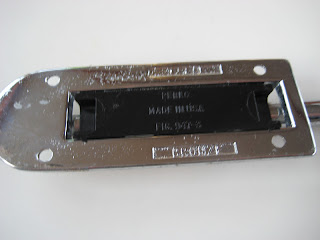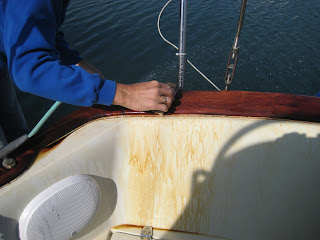A funny thing happened at the dock one morning this week. Right in the middle of breakfast we suddenly lost shore power and the inverter kicked in. The AC main breaker on the boat didn't trip but the 'reverse polarity' light came on. A quick check of the breaker on the dock showed it hadn't tripped and suggested a problem in the shore power cord. There was!
 |
| Oops! |
The interesting thing about this failure is that we had already planned to replace the Marinco twist lock plug and receptacle with a Smart Plug unit, it had already been ordered and unbelievably it showed up on the same day the Marinco failed......timing is everything!
The scary thing about the failure is that we always check the Marinco set up weekly for any signs of prong corrosion or discoloration due to overheating and saw nothing to hint at a problem developing so, clearly, our inspection regimen wasn't worth a hill of beans! The only two things drawing AC power at the time of the failure were the water heater (Seaward) and a small space heater, both of which are 1500 Watt rated. We knew that those two items alone could draw close to 25 Amps for short periods (if the water heater cycled while the space heater was on 'high') but we have operated them together for many months with no problems and felt that we had enough of a cushion in terms of supply capacity at 30 Amps. We may have to reassess that assumption but, even if we did momentarily exceed the system capacity, we should have been popping overloaded breakers not melting hardware.
The scary thing about the failure is that we always check the Marinco set up weekly for any signs of prong corrosion or discoloration due to overheating and saw nothing to hint at a problem developing so, clearly, our inspection regimen wasn't worth a hill of beans! The only two things drawing AC power at the time of the failure were the water heater (Seaward) and a small space heater, both of which are 1500 Watt rated. We knew that those two items alone could draw close to 25 Amps for short periods (if the water heater cycled while the space heater was on 'high') but we have operated them together for many months with no problems and felt that we had enough of a cushion in terms of supply capacity at 30 Amps. We may have to reassess that assumption but, even if we did momentarily exceed the system capacity, we should have been popping overloaded breakers not melting hardware.
The reason we checked the shore power connections so frequently and had a replacement on order is that the Marinco/Hubbel type twist lock plug and socket arrangement is a very old and fundamentally weak design. Despite dominating the marine market they aren't waterproof, the exposed contact prongs on the plug are easily damaged, the prongs don't provide solid engagement and the plastic locking ring is easily cross threaded or broken. Failures of this type of plug and socket are quite common. As full time liveaboards we use a lot of AC power from the dock supply and so there is a lot of thermal cycling through our shore power cord that can accelerate corrosion and loosen wire clamp screws, either of which can cause a failure like the one we experienced here.
By way of contrast, the Smart Plug addresses all the shortcomings of the twist lock design plus it is less susceptible to wear or damage to the contact prongs. It is a great product. There is an excellent video on their web site that steered us through each step of the installation.
By way of contrast, the Smart Plug addresses all the shortcomings of the twist lock design plus it is less susceptible to wear or damage to the contact prongs. It is a great product. There is an excellent video on their web site that steered us through each step of the installation.
Countersinking and cleaning up the nasty factory drilled mounting holes that we have come to expect. As an aside, we have been searching for a nice looking blanking cover for the (disconnected) telephone inlet sitting below the AC inlet, but so far no luck. We will probably end up making something out of Starboard.
The replacement of the female receptacle was very easy. The Smart Plug mounting screws are exactly the same pattern as the twist lock receptacle and after cleaning the old sealant off the cockpit wall, the Smart Plug receptacle was quickly mounted. Once again we used butyl mastic around the mounting screws for sealing.
Here is the finished receptacle mounted to the cockpit wall. Notice the sturdy contact prongs, well protected in the recessed body, and the double lipped seal inside the hinged cap.
Here is a shot of the closed receptacle. Clean and tidy.
The male side of the Smart Plug was a bit more fiddly, in particular getting the sealing sleeve into the plug body and over the cord, but we got it after only one false start. This shot shows our goof...the sleeve should have been fitted into the plug body before sliding it onto the cord.
We got it right on the second attempt.
Getting the three conductors into their respective slots was also a fiddle because the big molded cord clamps get in the way. Patience is a virtue for this bit!
UPDATE - April 2017
On later versions of the Smart Plug the integral molded cord clamps have been replaced by a separate clamp bar with screw fasteners that is much easier and simpler to use.
Here is the completed plug assembled onto the cord.
Here is the finished conversion. We did the whole job in around an hour, including the two attempts at getting the sealing sleeve onto the cord and a short tea break. We will sleep a little more soundly knowing this conversion has been done.



























































